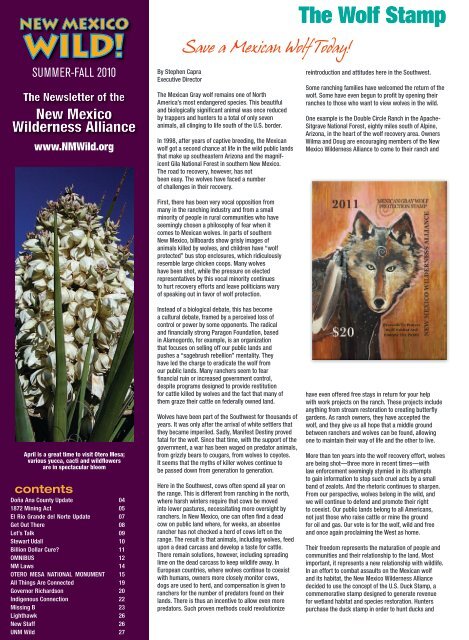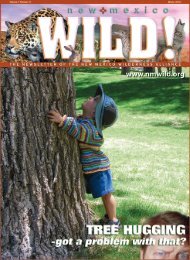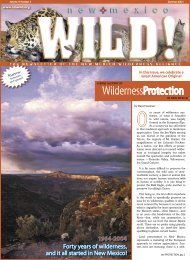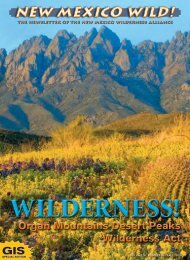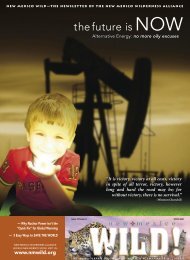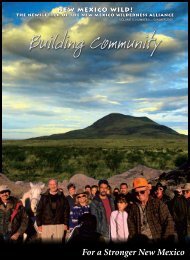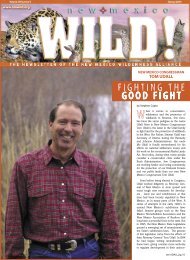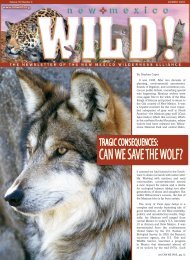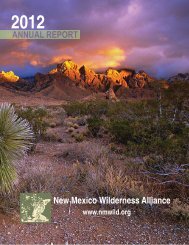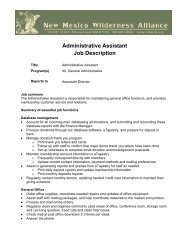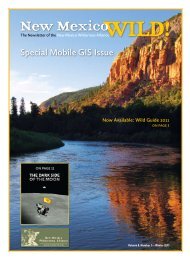Summer 2010 Newsletter - New Mexico Wilderness Alliance
Summer 2010 Newsletter - New Mexico Wilderness Alliance
Summer 2010 Newsletter - New Mexico Wilderness Alliance
Create successful ePaper yourself
Turn your PDF publications into a flip-book with our unique Google optimized e-Paper software.
The Wolf Stamp<br />
SUMMER-FALL <strong>2010</strong><br />
The <strong><strong>New</strong>sletter</strong> of the<br />
<strong>New</strong> <strong>Mexico</strong><br />
<strong>Wilderness</strong> <strong>Alliance</strong><br />
www.NMWild.org<br />
April is a great time to visit Otero Mesa;<br />
various yucca, cacti and wildflowers<br />
are in spectacular bloom<br />
contents<br />
By Stephen Capra<br />
Executive Director<br />
Save a Mexican Wolf Today!<br />
The Mexican Gray wolf remains one of North<br />
America’s most endangered species. This beautiful<br />
and biologically significant animal was once reduced<br />
by trappers and hunters to a total of only seven<br />
animals, all clinging to life south of the U.S. border.<br />
In 1998, after years of captive breeding, the Mexican<br />
wolf got a second chance at life in the wild public lands<br />
that make up southeastern Arizona and the magnificent<br />
Gila National Forest in southern <strong>New</strong> <strong>Mexico</strong>.<br />
The road to recovery, however, has not<br />
been easy. The wolves have faced a number<br />
of challenges in their recovery.<br />
First, there has been very vocal opposition from<br />
many in the ranching industry and from a small<br />
minority of people in rural communities who have<br />
seemingly chosen a philosophy of fear when it<br />
comes to Mexican wolves. In parts of southern<br />
<strong>New</strong> <strong>Mexico</strong>, billboards show grisly images of<br />
animals killed by wolves, and children have “wolf<br />
protected” bus stop enclosures, which ridiculously<br />
resemble large chicken coops. Many wolves<br />
have been shot, while the pressure on elected<br />
representatives by this vocal minority continues<br />
to hurt recovery efforts and leave politicians wary<br />
of speaking out in favor of wolf protection.<br />
Instead of a biological debate, this has become<br />
a cultural debate, framed by a perceived loss of<br />
control or power by some opponents. The radical<br />
and financially strong Paragon Foundation, based<br />
in Alamogordo, for example, is an organization<br />
that focuses on selling off our public lands and<br />
pushes a “sagebrush rebellion” mentality. They<br />
have led the charge to eradicate the wolf from<br />
our public lands. Many ranchers seem to fear<br />
financial ruin or increased government control,<br />
despite programs designed to provide restitution<br />
for cattle killed by wolves and the fact that many of<br />
them graze their cattle on federally owned land.<br />
Wolves have been part of the Southwest for thousands of<br />
years. It was only after the arrival of white settlers that<br />
they became imperiled. Sadly, Manifest Destiny proved<br />
fatal for the wolf. Since that time, with the support of the<br />
government, a war has been waged on predator animals,<br />
from grizzly bears to cougars, from wolves to coyotes.<br />
It seems that the myths of killer wolves continue to<br />
be passed down from generation to generation.<br />
reintroduction and attitudes here in the Southwest.<br />
Some ranching families have welcomed the return of the<br />
wolf. Some have even begun to profit by opening their<br />
ranches to those who want to view wolves in the wild.<br />
One example is the Double Circle Ranch in the Apache-<br />
Sitgrave National Forest, eighty miles south of Alpine,<br />
Arizona, in the heart of the wolf recovery area. Owners<br />
Wilma and Doug are encouraging members of the <strong>New</strong><br />
<strong>Mexico</strong> <strong>Wilderness</strong> <strong>Alliance</strong> to come to their ranch and<br />
have even offered free stays in return for your help<br />
with work projects on the ranch. These projects include<br />
anything from stream restoration to creating butterfly<br />
gardens. As ranch owners, they have accepted the<br />
wolf, and they give us all hope that a middle ground<br />
between ranchers and wolves can be found, allowing<br />
one to maintain their way of life and the other to live.<br />
More than ten years into the wolf recovery effort, wolves<br />
are being shot—three more in recent times—with<br />
law enforcement seemingly stymied in its attempts<br />
to gain information to stop such cruel acts by a small<br />
band of zealots. And the rhetoric continues to sharpen.<br />
From our perspective, wolves belong in the wild, and<br />
we will continue to defend and promote their right<br />
to coexist. Our public lands belong to all Americans,<br />
not just those who raise cattle or mine the ground<br />
for oil and gas. Our vote is for the wolf, wild and free<br />
and once again proclaiming the West as home.<br />
waterfowl. For generations, sportsmen<br />
have used hunting as a vehicle to<br />
fund government programs dealing<br />
with habitat restoration, species<br />
protection, and the purchase of<br />
new lands for wildlife refuges, etc.<br />
With such funding, sportsmen have<br />
garnered great political strength.<br />
In the case of the wolf stamp, hunting<br />
is not permitted. Rather, the series<br />
of yearly commemorative stamps<br />
will be issued to raise money that<br />
will be devoted to three areas.<br />
It is important to note that 99 percent<br />
of all proceeds raised by the <strong>New</strong><br />
<strong>Mexico</strong> <strong>Wilderness</strong> <strong>Alliance</strong> from sales<br />
of the wolf stamp will go directly to<br />
protecting the Mexican wolf. This is<br />
not a direct fundraiser for the <strong>New</strong><br />
<strong>Mexico</strong> <strong>Wilderness</strong> <strong>Alliance</strong> but rather<br />
a direct fundraiser for the Mexican<br />
wolf. The NMWA will create a small<br />
committee, made up of staff and<br />
Board members, that will determine<br />
to what organizations or to which<br />
proposals the monies raised will go.<br />
First, money will go for public education.<br />
Groups like the Mexican Wolf Coalition<br />
will be eligible for receiving grants.<br />
Also eligible would be a filmmaker<br />
working on a documentary about wolves<br />
or schools working with students to<br />
better educate them on the importance<br />
of wolves to a balanced ecosystem.<br />
Second, grants will be awarded to<br />
implement habitat restoration in wolf<br />
country on state lands, in conjunction<br />
with the <strong>New</strong> <strong>Mexico</strong> Department of<br />
Game and Fish. Finally, we want to<br />
help the situation south of the border,<br />
where funds go the extra mile, so<br />
we will extend funds to Mexican<br />
conservation groups like Naturalia<br />
that are working to reintroduce<br />
Mexican wolves to parts of <strong>Mexico</strong>.<br />
Five thousand wolf stamps have been<br />
specially created and die-cut. With your<br />
support, we can raise $100,000 dollars<br />
for the Mexican wolf through the sale of<br />
the stamp. As conservationists, we can<br />
also develop the political influence that<br />
comes with directly funding important<br />
wildlife and restoration issues.<br />
We’ll Miss Governor Richardson<br />
Buying the wolf stamp will not stop<br />
the hate or the violence, but it will<br />
help us educate people and—we<br />
hope—combat the fear and the<br />
misinformation. It will allow streams<br />
to be restored, illegal roads used by<br />
off-road vehicles to be blocked, and,<br />
for our friends in <strong>Mexico</strong>, it will help<br />
fight back against the same voices of<br />
doubt and fear that we face here in<br />
<strong>New</strong> <strong>Mexico</strong>. The bottom line is that<br />
your twenty-dollar investment will<br />
help make clear that people in our<br />
state and across the country want the<br />
Mexican wolf to survive and thrive in<br />
the wild public lands of the West.That,<br />
for politicians, is frankly priceless.<br />
Buy your wolf stamp today. For<br />
more information, go to our Web<br />
site at www.nmwild.org or call<br />
505-843-8696 and ask for Roger.<br />
Please help us by sharing this article<br />
with friends and family and with other<br />
conservation groups across the country.<br />
Money raised goes directly to supporting<br />
efforts to protect the Mexican wolf.<br />
Main Office<br />
505/843-8696 • fax 505/843-8697<br />
nmwa@nmwild.org • www.nmwild.org<br />
P.O. Box 25464, Albuquerque, NM 87125<br />
Las Cruces Field Office<br />
275 N. Downtown Mall<br />
Las Cruces, NM 88001<br />
575/527-9962<br />
Santa Fe Field Office<br />
341 E Alameda St<br />
Santa Fe, NM 87501<br />
505/216-9719<br />
Mission Statement<br />
The <strong>New</strong> <strong>Mexico</strong> <strong>Wilderness</strong> <strong>Alliance</strong> is<br />
dedicated to the protection, restoration,<br />
and continued enjoyment of <strong>New</strong> <strong>Mexico</strong>’s<br />
wildlands and <strong>Wilderness</strong> areas.<br />
NMWA Staff<br />
Albuquerque Office<br />
Stephen Capra, Executive Director<br />
Nathan <strong>New</strong>comer, Associate Director<br />
Tisha Broska, Development Director<br />
Roxanne Pacheco, Finance Manager<br />
Trisha London, Membership & Grassroots Assistant<br />
Craig Chapman, Special Events Coordinator<br />
Roger Turner: Member and Volunteer Coordinator<br />
Leona Morgan, Native Nations Liason<br />
Rachael Freund, Bureau Chief<br />
Carlsbad Office<br />
Steve West, Staff Scientist<br />
Las Cruces Office<br />
Jeff Steinborn, Southern Director<br />
Nathan Small, <strong>Wilderness</strong> Protection Coordinator<br />
Santa Fe Office<br />
Demis Foster, Community Partnership Dir.<br />
Northern <strong>New</strong> <strong>Mexico</strong><br />
John Olivas, Northern Director<br />
Silver City Office<br />
Kim McCreery, Outreach Coordinator<br />
Board of Directors<br />
Jim Hickerson, Cedar Crest, NM (Chair)<br />
Bob Tafanelli, Las Cruces, NM (Vice-Chair)<br />
Nancy Morton, Albuquerque, NM (Secretary)<br />
Nancy Murray, Albuquerque, NM (Co-Treasurer)<br />
Tripp Killin, Albuquerque, NM (Co-Treasurer)<br />
Rick C. Aster, Socorro, NM<br />
Ken Cole, Albuquerque, NM<br />
Esther Garcia, Questa, NM<br />
Todd Schulke, Silver City, NM<br />
Brooke Williams, Moab, UT<br />
Gary Glenn Hartwick, Roswell, NM<br />
David Soules, Las Cruces, NM<br />
Doug Chinn, Albuquerque, NM<br />
Dave Wheelock, Santa Fe, NM<br />
Claire Long, Questa, NM<br />
Advisory Council<br />
Phil Carter, Albuquerque, NM<br />
Dave Foreman, Albuquerque, NM<br />
Bob Howard, Santa Fe, NM<br />
Rick Wiedenmann, Carlsbad, NM<br />
Randy Gray, Missoula, MT<br />
Jim Baca, Albuquerque, NM<br />
<strong><strong>New</strong>sletter</strong> Staff<br />
Nathan <strong>New</strong>comer, Managing Editor<br />
Joe Adair, Design Editor<br />
Hilary Handelsman, Copy Editor<br />
Here in the Southwest, cows often spend all year on<br />
the range. This is different from ranching in the north,<br />
What is <strong>Wilderness</strong>?<br />
Doña Ana County Update 04<br />
where harsh winters require that cows be moved<br />
1872 Mining Act 05<br />
into lower pastures, necessitating more oversight by<br />
The <strong>Wilderness</strong> Act of 1964<br />
established the National <strong>Wilderness</strong><br />
El Rio Grande del Norte Update 07<br />
ranchers. In <strong>New</strong> <strong>Mexico</strong>, one can often find a dead<br />
Preservation System to preserve<br />
Get Out There 08<br />
cow on public land where, for weeks, an absentee<br />
the last remaining wildlands in<br />
Let’s Talk 09<br />
rancher has not checked a herd of cows left on the<br />
America. The <strong>Wilderness</strong> Act, as<br />
Stewart Udall 10<br />
range. The result is that animals, including wolves, feed<br />
federal policy, secures “an enduring<br />
Billion Dollar Cure? 11<br />
upon a dead carcass and develop a taste for cattle. Their freedom represents the maturation of people and<br />
resource of wilderness” for the<br />
OMNIBUS 12<br />
There remain solutions, however, including spreading communities and their relationship to the land. Most<br />
people. <strong>Wilderness</strong> is defined as<br />
lime on the dead carcass to keep wildlife away. In<br />
an area that has primarily been<br />
NM Laws 14<br />
important, it represents a new relationship with wildlife.<br />
European countries, where wolves continue to coexist In an effort to combat assaults on the Mexican wolf<br />
affected by the forces of nature with<br />
OTERO MESA NATIONAL MONUMENT 15<br />
with humans, owners more closely monitor cows, and its habitat, the <strong>New</strong> <strong>Mexico</strong> <strong>Wilderness</strong> <strong>Alliance</strong><br />
the imprint of humans substantially<br />
All Things Are Connected 19<br />
dogs are used to herd, and compensation is given to<br />
unnoticeable. It is an area that offers<br />
decided to use the concept of the U.S. Duck Stamp, a<br />
Governor Richardson 20<br />
outstanding opportunity for solitude<br />
ranchers for the number of predators found on their commemorative stamp designed to generate revenue<br />
Indigenous Connection 22<br />
or a primitive or unconfined type of<br />
lands. There is thus an incentive to allow even more for wetland habitat and species restoration. Hunters<br />
recreation, and an area that contains<br />
Missing B 23<br />
predators. Such proven methods could revolutionize purchase the duck stamp in order to hunt ducks and<br />
ecological, geological, or other<br />
Lighthawk 26<br />
features of scientific, educational,<br />
<strong>New</strong> Staff 26<br />
scenic, or historical value.<br />
UNM Wild 27<br />
Page 2 SUMMER-FALL <strong>2010</strong><br />
<strong>New</strong> <strong>Mexico</strong> WILD! • www.NMWild.org Page 3<br />
by Stephen Capra<br />
For the past eight years, <strong>New</strong> Mexicans<br />
have enjoyed a real conservation<br />
champion in Governor Richardson. In<br />
a state use to the oil and gas industry<br />
making the rules, Governor Richardson<br />
has taken many courageous stands.<br />
Who could forget the wonderful day at<br />
the Kimo Theater back in 2004 when<br />
the Governor made clear that he would<br />
not tolerate any drilling in Otero Mesa?<br />
In the following year, Governor<br />
Richardson again stood up to the oil<br />
and gas industry. His administration<br />
worked to pass common sense<br />
regulations, such as the Waste Pit<br />
Rule. This regulation came about after<br />
the state Oil Conservation Division<br />
released a report documenting nearly<br />
1,000 cases of groundwater contamination<br />
due to oil and gas operations.<br />
Since that time, the Governor has<br />
repeatedly shown leadership in<br />
helping to protect the Valle Vidal;<br />
water protections for the state and<br />
using the bully pulpit to speak out<br />
for wildlife, wilderness and Global<br />
Climate Change. More than anything<br />
the Governor has been open and<br />
responsive to the concerns of the<br />
conservation community. He has<br />
taken the time to meet with and<br />
hear our concerns – something<br />
that has been in short supply from<br />
recent <strong>New</strong> <strong>Mexico</strong> Governors.<br />
The Governor is a true sportsman, who<br />
knows how to handle the reigns of<br />
a horse as easily as he pushed forth<br />
important legislation in the past eight<br />
years. We can only now say thank<br />
you Governor Richardson. You have<br />
been a real leader; never afraid to<br />
speak out on important conservation<br />
issues, and never waiting to see if<br />
the political climate was right. You<br />
always understood this was not about<br />
politics, but more a question of our<br />
moral fiber as a community and a<br />
state. One thing is clear, you courageous<br />
stances will be sorely missed,<br />
and we wish you continued success<br />
and hope you will remain a strong<br />
voice for wilderness and wildlife.<br />
Read about Governor Richardson’s environmental<br />
accomplishments on page 20


